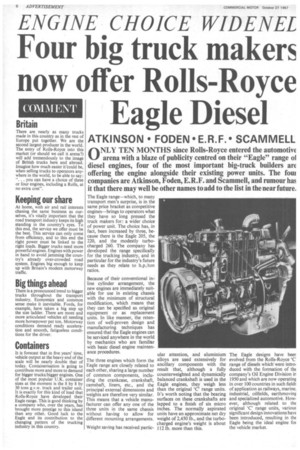ENGINE CHOICE WIDENEL
Page 8

If you've noticed an error in this article please click here to report it so we can fix it.
Four big truck makers now offer Rolls-Royce Eagle Diesel
ATKINSON • FODEN • ER. F. • SCAMMELL
0NLY TEN MONTHS since Rolls-Royce entered the automotive arena with a blaze of publicity centred on their "Eagle" range ol diesel engines, four of the most important big-truck builders are offering the engine alongside their existing power units. The four companies are Atkinson, Foden, E.R.F. and Scammell, and rumour has it that there may well be other names to add to the list in the near future.
The Eagle range—which, to many transport men's surprise, is in the same price bracket as competitive engines—brings to operators what they have so long pressed the truck makers for: a wider choice of power unit. The choice has, in fact, been increased by three, because there is the Eagle 205, the 220, and the modestly turbocharged 260. The company has developed the range specifically for the trucking industry, and in particular for the industry's future needs as they relate to h.p./ton ratios.
Because of their conventional inline cylinder arrangement, the new engines are immediately suitable for use in existing chassis with the minimum of structural modification, which means that they can be specified as original equipment or as replacement units. In like manner, the retention of well-proven design and manufacturing techniques has ensured that the Eagle engines can be serviced anywhere in the world by mechanics who are familiar with basic diesel engine maintenance procedures.
The three engines which form the Eagle range are closely related to each other, sharing a large number of common components, including the crankcase, crankshaft, camshaft, liners, etc., and the principal external dimensions and weights are therefore very similar. This means that a vehicle manufacturer can offer any one of the three units in the same chassis without having to allow for different mounting arrangements.
Weight saving has received partic ular attention, and aluminium alloys are used extensively for ancillary components with the result that, although a fully counterweighted and dynamically balanced crankshaft is used in the Eagle engines, they, weigh less than the original 'C' range units. It's worth noting that the bearing surfaces on these crankshafts are lapped to a finish of six micro inches. The normally aspirated units have an approximate net dry weight of 2,450 lb., and the turbocharged engine's weight is about 112 lb. more than this. The Eagle designs have beer evolved from the Rolls-Royce `C range of diesels whicti were introduced with the formation of the company's Oil Engine Division in 1950 and which are now operating in over 100 countries in such fields of application as railways, marine industrial, oilfields, earthmoving and specialized automotive. However, although related to thc original 'C' range units, various significant design innovations hay( been introduced, resulting in tht Eagle being the ideal engine foi the vehicle market.






















































































































